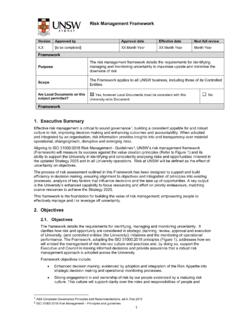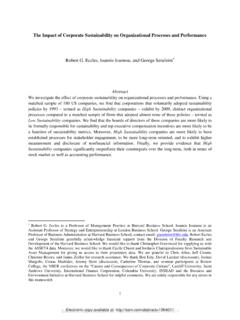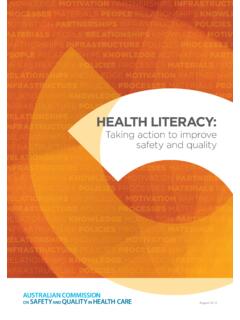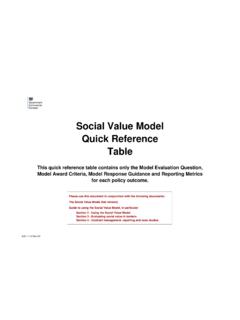Transcription of Risk Management Framework
1 1 Risk Management Framework Version Approved by Approval date Effective date Next full review V4 Risk Committee of Council 20 November 2020 20 November 2020 November 2021 Framework Purpose The Risk Management Framework provides the foundations for Management of risks at the University, including the requirements for identifying, managing and monitoring uncertainty to maximise the upside and minimise the downside of risk. Scope The Framework applies to all University business, including those of its Controlled Entities. Are Local Documents on this subject permitted? Yes, however Local Documents must be consistent with this University-wide Document. No Framework 1. Executive Summary Commitment The University is committed to building a risk-aware culture that is supported by a tailored, practical and integrated approach to the identification and Management of uncertainty inherent in our strategy, operations and the global environment in which we exist.
2 This commitment is articulated in the Risk Management Policy and championed by our leaders. Risk Definition Risk at UNSW is defined as the effect of uncertainty on objectives. Adopting the ISO 31000: 2018 Risk Management Guidelines 1 definition of risk, a risk is an uncertain event ( an occurrence or change of a particular set of circumstances) that, if it materialises, will affect (positively or negatively) the achievement of one or more of the University s objectives. The magnitude of a risk will be assessed by qualifying the nature of the impact (positive or negative), its likelihood of occurrence, the effectiveness of existing controls and, if appropriate, the velocity at which the risk will impact the University. Overview Effective risk Management is critical to sound governance2, building a consistent appetite for, and robust culture in risk, improving decision - making and enhancing outcomes and accountability.
3 When adopted and integrated by an organisation, risk information provides insights into , and transparency over material operational, change / growth and disruptive / emerging risks. This Risk Management Framework (the Framework ) is the foundation for building the value of risk Management , empowering people to effectively manage uncertainty. It articulates the requirements for identifying, managing and monitoring risks. It clarifies how risk and opportunity are considered in strategic planning, review, approval and execution of University initiatives and in the monitoring of operational performance. The Framework , adopting the ISO 31000: 2018 principles (Figure 1) and examples of evidence, addresses how we will embed the Management of risk into our culture and practices and, by doing so, supports the Executive and Council in making informed decisions and provides assurance that a robust risk Management approach is adopted across the University.
4 The process of risk assessment outlined in this Framework has been designed to improve our understanding of risks, enhance our decision - making , minimise threats, leverage opportunities and maximise successful University outcomes by aligning resources to priority endeavours to achieve the Strategy 2025. 1 ISO 31000:2018 Risk Management Principles and guidelines 2 ASX Corporate Governance Principles and Recommendations, ed 4, Feb 2019 2 Figure 1: ISO 310000 2018 - Value Creation and Protection Principles Objectives and Benefits of Risk Management The objective of Risk Management is to protect and create value by improving the University s understanding, Management and communication of threats and opportunities. Effective risk Management should enhance decision - making , including resourcing of priorities, assist us in meeting our compliance obligations and maximise successful outcomes.
5 The UNSW Risk Management Framework seeks to enable effective risk Management by: Providing risk tools that are aligned to business needs and integrated into University processes Creating the foundations to build the required capability across the University to enable its people to identify, understand and manage risks Creating and enhancing a risk-aware culture by embedding a consistent application of the University s Risk Appetite into all strategic decision - making processes to drive salient risk discussions and aligned decisions Providing a consistent structure for the application of the risk Management process and principles, proportionate to the level of risk, effectiveness of the control environment and the potential velocity of impact of the risk on UNSW s operations Enabling the ongoing review and interrogation of risk Management performance using available data/indicators, industry-leading practices and feedback from stakeholders 3 2.
6 Framework Architecture Our Framework has been designed to align with the governance Framework practices and reporting, to accommodate the organisational structure and to meet the requirements of ISO 31000:2018 Risk Management Guidelines. The Framework includes the following elements: Risk Appetite (Section 3) The Risk Management Process (Section 4) Risk Capabilities (Section 5) Framework Application and Implementation (Section 6) Risk Accountabilities and Responsibilities (Section 7) Monitoring and Review of the Framework (Section 8) The Framework also encompasses the suite of tools to support the application of risk Management efforts, including related frameworks, supporting procedures, guidelines, training aids and templates. 3. Risk Appetite Purpose of Risk Appetite Statement The Risk Appetite Statement (RAS) defines the type and degree of risk the University is willing to accept to achieve its strategic aspirations.
7 Its purpose is to guide University governance bodies, leaders and staff in decision - making . It does so by defining the boundaries for risk-taking, thereby aligning decisions to the risk appetite. These boundaries detail the principles and metrics, both quantitative and qualitative, that, when reviewed as a collective, assist in decision - making . The RAS is to be used to review any activity that may impact the University and its controlled entities at an enterprise (whole of university) level. Approach to Risk Appetite The University supports a positive risk culture, where individuals are empowered to take measured risks to achieve the strategic priorities and to act within UNSW s Behaviours guideline. Conversely, activities that materially threaten the viability of the University and its strategic objectives will not be supported.
8 Implementation of the RAS requires consideration of the risk appetite parameters as part of the strategic initiative viability, feasibility and approval processes and as part of the operational decision - making for governance and Management forums. Where an initiative or operational performance outcome falls into the tolerance range ( where an initiative or operational outcome may impact the stated appetite but does not fall within the unacceptable/no appetite statement), a risk evaluation is required. Mitigation actions must demonstrate how they will re-align the initiative or performance to the RAS. This is outlined in the diagram below: 4 Figure 2: Applied Risk Appetite process The University s Risk Appetite Statement is currently under review.
9 Unacceptable Risk Outcomes No Appetite No Appetite qualifications reflect the actions that are contrary to the Strategy 2025 and our UNSW Behaviours guideline. These include (but will be revised as part of the RAS review): Activity that compromises the University s legal and regulatory obligations Situations where those interacting with the University are recklessly harmed Research funded by organisations that are not aligned to UNSW values Activities that compromise the University s academic quality and integrity for staff and students Actions that adversely impact the University s financial resilience NOTE: Refinement of the UNSW RAS is currently underway to address: Limited connection between the RAS guidance and metrics to decision - making processes Limited ability to translate the RAS guidance and metrics to monitoring of operational performance and reporting This section will be updated once ratified by the Management Board (MB) and Senior Leadership Team (SLT) and endorsed by the Risk Committee.
10 Where there are areas of uncertainty, the risk and mitigations will be identified and demonstrate how the initiative or operation will be delivered within appetite. This information will be central to the decision - making . Given the context of the initiative or operational task, ensure lead and lag indicators are clearly identified and demonstrate alignment with the RAS. Clarify the Governance Forum responsible for monitoring the endeavor and those persons accountable for delivering the endeavor within RAS. Where there are areas of uncertainty, the risk and mitigations will be identified and demonstrate how the initiative or operation will be delivered within appetite. This information will be central to the decision making .








